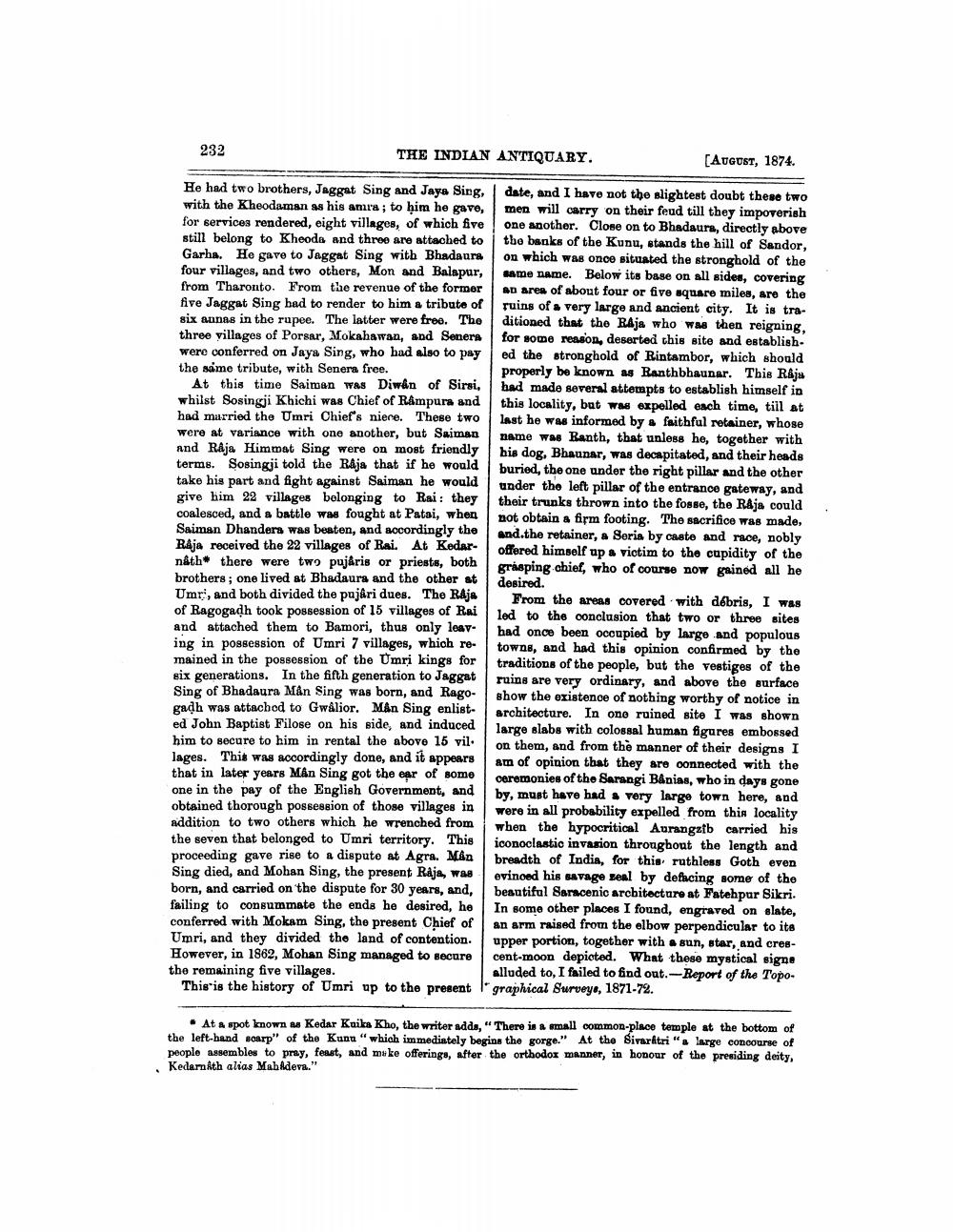________________
232
THE INDIAN ANTIQUARY.
He had two brothers, Jaggat Sing and Jaya Sing, with the Kheodaman as his amra; to him he gave, for services rendered, eight villages, of which five still belong to Kheoda and three are attached to Garha. He gave to Jaggat Sing with Bhadaura four villages, and two others, Mon and Balapur, from Tharonto. From the revenue of the former five Jaggat Sing had to render to him a tribute of six annas in the rupee. The latter were free. The three villages of Porsar, Mokahawan, and Senera were conferred on Jaya Sing, who had also to pay the same tribute, with Senera free.
[AUGUST, 1874.
date, and I have not the slightest doubt these two men will carry on their feud till they impoverish one another. Close on to Bhadaura, directly above the banks of the Kunu, stands the hill of Sandor, on which was once situated the stronghold of the same name. Below its base on all sides, covering an area of about four or five square miles, are the ruins of a very large and ancient city. It is traditioned that the Raja who was then reigning, for some reason, deserted this site and established the stronghold of Rintambor, which should properly be known as Ranthbhaunar. This Raja had made several attempts to establish himself in this locality, but was expelled each time, till at last he was informed by a faithful retainer, whose name was Ranth, that unless he, together with his dog, Bhaunar, was decapitated, and their heads buried, the one under the right pillar and the other under the left pillar of the entrance gateway, and their trunks thrown into the fosse, the Raja could not obtain a firm footing. The sacrifice was made, and.the retainer, a Seria by caste and race, nobly offered himself up a victim to the cupidity of the grasping chief, who of course now gained all he desired.
At this time Saiman was Diwan of Sirsi, whilst Sosingji Khichi was Chief of Rampura and had married the Umri Chief's niece. These two were at variance with one another, but Saiman and Raja Himmat Sing were on most friendly terms. Sosingji told the Raja that if he would take his part and fight against Saiman he would give him 22 villages belonging to Rai: they coalesced, and a battle was fought at Patai, when Saiman Dhandera was beaten, and accordingly the Rája received the 22 villages of Rai. At Kedarnåth there were two pujâris or priests, both brothers; one lived at Bhadaura and the other at Umr, and both divided the pujâri dues. The Raja of Ragogadh took possession of 15 villages of Rai and attached them to Bamori, thus only leaving in possession of Umri 7 villages, which remained in the possession of the Umri kings for six generations. In the fifth generation to Jaggat Sing of Bhadaura Mân Sing was born, and Ragogadh was attached to Gwalior. Man Sing enlisted John Baptist Filose on his side, and induced him to secure to him in rental the above 15 vil. lages. This was accordingly done, and it appears that in later years Mân Sing got the ear of some one in the pay of the English Government, and obtained thorough possession of those villages in addition to two others which he wrenched from the seven that belonged to Umri territory. This proceeding gave rise to a dispute at Agra. Mân Sing died, and Mohan Sing, the present Raja, was born, and carried on the dispute for 30 years, and, failing to consummate the ends he desired, he conferred with Mokam Sing, the present Chief of Umri, and they divided the land of contention. However, in 1862, Mohan Sing managed to secure the remaining five villages. This is the history of Umri up to the present graphical Surveys, 1871-72.
From the areas covered with débris, I was led to the conclusion that two or three sites had once been occupied by large and populous towns, and had this opinion confirmed by the traditions of the people, but the vestiges of the ruins are very ordinary, and above the surface show the existence of nothing worthy of notice in architecture. In one ruined site I was shown large slabs with colossal human figures embossed on them, and from the manner of their designs I am of opinion that they are connected with the ceremonies of the Sarangi Bânias, who in days gone by, must have had a very large town here, and were in all probability expelled from this locality when the hypocritical Aurangzib carried his iconoclastic invasion throughout the length and breadth of India, for this ruthless Goth even evinced his savage zeal by defacing some of the beautiful Saracenic architecture at Fatehpur Sikri. In some other places I found, engraved on slate, an arm raised from the elbow perpendicular to its upper portion, together with a sun, star, and crescent-moon depicted. What these mystical signe alluded to, I failed to find out.-Report of the Topo
At a spot known as Kedar Kuika Kho, the writer adds, "There is a small common-place temple at the bottom of the left-hand scarp" of the Kunu "which immediately begins the gorge." At the Sivaratri "a large concourse of people assembles to pray, feast, and make offerings, after the orthodox manner, in honour of the presiding deity, Kedarnath alias Mahadeva."




